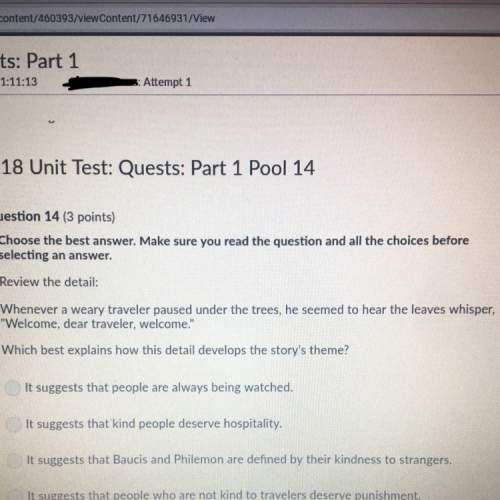Civil Disobedience
Part 2:
Thoreau’s ideas had a profound effect on a man na...

English, 05.05.2020 20:34 karlaperez8963
Civil Disobedience
Part 2:
Thoreau’s ideas had a profound effect on a man named Gandhi. Gandhi, was a leader in India who worked to end British rule. He led India to independence and inspired many to non-violent forms of protest and resistance. He fought to end poverty, worked to expand women's right to vote, and built bridges between ethnic and religious groups. Like Thoreau, he lived simply, owned very little, and ate a vegetarian diet. In India, Gandhi's form of protest was called the "non-cooperation movement." He urged Indians to boycott British education systems and leave government jobs. The movement was very popular, and in part to stop its spread, the British controlled government arrested him. After a few years, he was released and became active in politics again. He inspired many to follow him on marches to protest various taxes. On one such march, thousands followed him 240 miles over 24 days to the sea to protest a salt tax. This march set the example of non-violent resistance to the government that others in the country followed. Eventually India won independence from Britain, in large part because of Gandhi work.
Gandhi's model of resistance and reform was creative, appealing, and successful. As a result, Dr. Martin Luther King looked to Gandhi when the time came to find a way to resist segregation in the South. The lunch counter protests, famous for the passive response to anger, and even violence, aimed to end the separation enforced by laws in some regions of the South. King also organized walks, marches, and bus rides that were meant to bring attention to the issues facing African Americans. These forms of protest were directly modeled on Gandhi's, but King took them straight to the source of oppression. Where Gandhi's protests created awareness and built momentum, King's protests were in the face of great hatred and fear. The passive, non-violent protests were ultimately effective, mainly because the passive response to violence cast the opposition as brutes. However, change came slowly and at the cost of many lives. King remained committed to peaceful protest, however, until his death. King learned from Gandhi, expanding on what worked, applying old techniques to a new problem. Gandhi owed his philosophy, in part, to a New England poet who loved the woods.
How did Gandhi and King further Thoreau's idea of civil disobedience?
They did not ask others to join their cause just as Thoreau did.
They gave their followers a better model for disobedience than Thoreau.
They had less to lose than Thoreau and those who opposed slavery.
They recruited and encouraged others to disobey in an organized effort.

Answers: 1


Another question on English

English, 21.06.2019 15:00
Read the selection below and answer the question. an open boat by alfred noyes o, what is that whimpering there in the darkness?
'let him lie in my arms. he is breathing, i know.
look. i'll wrap all my hair round his neck' – the sea's rising,
the boat must be lightened. he's dead. he must go.'
see - quick - by that flash, where the bitter foam tosses,
the cloud of white faces, in the black open boat,
and the wild pleading woman that clasps her dead lover
and wraps her loose hair round his breast and his throat.
'come, lady, he's dead.' - 'no, i feel his heart beating,
he's living, i know. but he's numbed with the cold.
see, i'm wrapping my hair all around him to warm him.' -
- 'no. we can't keep the dead, dear. come, loosen your hold.
'come. loosen your fingers.' - 'o god, let me keep him! ' -
o, hide it, black night! let the winds have their way!
and there are no voices or ghosts from that darkness,
to fret the bare seas at the breaking of day. which choice best describes the conflict in this poem? the winds are rocking the boat. a man is thrown into the sea. a woman doesn’t want to let go of her dead lover. someone is crying in the darkness.
Answers: 3

English, 21.06.2019 15:50
Read these lines from "an open boat" and answer the question. an open boat by alfred noyes see - quick - by that flash, where the bitter foam tosses,
the cloud of white faces, in the black open boat,
which of the end rhymes below matches the one in the last line of the excerpt? “he’s living, i know. but he’s numbed with the cold.” “and there are no voices or ghosts in that darkness.” “and wraps her loose hair round his breast and his throat.” “come. loosen your fingers. – o god, let me keep him! ”
Answers: 3

English, 21.06.2019 22:30
Speaking rapidly in a large gymnasium causes your words to run together; making them hard to distinguish. true false
Answers: 2

English, 22.06.2019 06:30
How is “a brief study of guts” organized? cause and effect chronological order fact by fact problem-solution
Answers: 2
You know the right answer?
Questions



Computers and Technology, 11.03.2021 17:50

Mathematics, 11.03.2021 17:50


Mathematics, 11.03.2021 17:50


History, 11.03.2021 17:50






Mathematics, 11.03.2021 17:50

Biology, 11.03.2021 17:50


Computers and Technology, 11.03.2021 17:50






